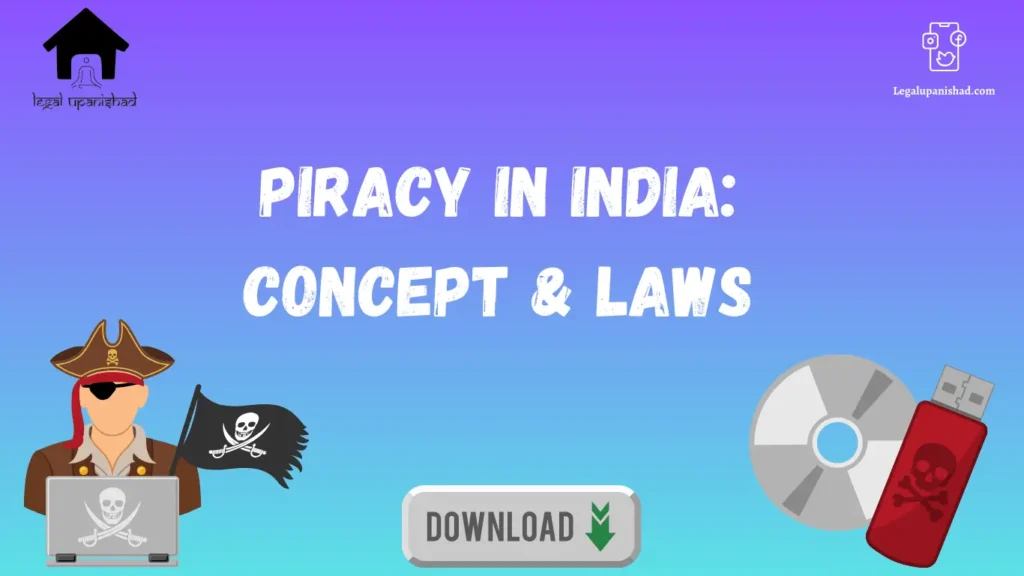This article on ‘Piracy in India: Concept and Laws’ was written by Tosani Lal, an intern at Legal Upanishad.
INTRODUCTION
An individual original work with respect to the creation of cinema, which is also referred to as intellectual property, if it is stolen and misappropriated by another person as their own and leaked on their or any other website, shall be considered piracy. It shall be pertinent to note that the act of piracy might have varying understanding and punishment for different nations, but the common factor in all is that such an act is considered unlawful.
In this article, we will try to understand the meaning of privacy in an Indian context and examine what legal measures the government has taken to protect individual work in the field of moviemaking.
DEFINITION
In the early days, piracy referred to acts amounting to maraud or illegal raiding, which usually occurred on a ship. The main object of such actions is to illegally obtain valuables and other significant belongings of other persons. In present times, this kind of act is defined as robbery, theft, or dacoity in Indian law. In terms of defining piracy, it now refers to the theft or misappropriation of one’s intellectual property, specifically with respect to copyrights. In other words, piracy is defined as infringement of copyrights for wrongful gain and causing damage to their intellectual property.
Piracy has become more common in the digital age. A person illegally secures and distributes digital documents and movies for the purpose of wrongful gain. With respect to movies, when a person illegally obtains the digital print of the movies and distributes or leaks them on the internet for free access, such acts result in monetary loss to the creator and owner, as well as severe financial damage to the film fraternity.
KINDS OF PIRACY
Piracy can be categorised into five different types.
- Counterfeiting : In the case of counterfeiting, there is the acquisition, replication, and sale of any copyright material through an illegal method.
- Internet Piracy: The act of illegally downloading any documents from an internet platform. Piracy on the internet was performed by sending invites for free software downloads and documents containing any important digital print. Peer-to-Peer, also known as P2P, is a file sharing system that aids in transfer programmes.
- End-User Piracy: In this category of privacy, there is reproduction of the software through illegal methods. In other words, the user is not authorised to perform the act of reproducing such software.
- Client-Server Overuse: The situation where the clients of a certain server licence prescribed is exceeded, then the required in a computer network platform is referred to as overuse piracy or client-server overuse.
- Hard-Disk Loading: In this situation, a computer sold by a certain company also contains illegal sales software that is loaded into the hard disc with the object of making the sale and purchase of such devices more inviting.


LAWS ON PIRACY IN INDIA
In order to protect the rights of the owner of the intellectual property, especially the copyrights of individuals, the government has prescribed some legal measures and introduced laws with respect to the protection and punishment of piracy in India.
One of the most significant laws of piracy in Indian legislation is the Copyright (Amendment) Act, 2012, which incorporates two main sections to protect the copyright owner and punishes for the act of illegally accessing important information through the internet. These are Section 65A and Section 65B of the Copyright (Amendment) Act, 2012.
- Section 65(A): This provision safeguards Technological Protection Measures (TPM) employed by copyright owners. It imposes penalties on individuals attempting to circumvent technological measures established to safeguard rights outlined in the Act, intending to infringe upon those rights. Offenders may be subject to a maximum of two years of imprisonment along with a fine.
- Section 65(B): Focused on Information Rights Management (IRM), this section protects sensitive information from unauthorized access. It penalizes individuals who knowingly remove or alter rights management information without proper authority or distribute copyrighted works with the awareness that such information has been tampered with or removed without permission. Violators could face imprisonment for up to two years, coupled with fines.
Additionally, to the Copyright (Amendment) Act, 2012, the Information Technology Act, 2000 was introduced with the object of regulating laws on issues concerning the illegal sale of content that is subject to copyright. Section 66 of the Information Technology Act, 2000 deals with breach of a computer-related offence and shall be penalised for three years of imprisonment and levied with a fine that can be extended to five lakh rupees.
Furthermore, on July 20, 2023, the Cinematography (Amendment) Bill, 2023, was brought up in the Rajya Sabha with the object of certifying films for exhibition. These legislative measures collectively aim to curb digital piracy and reinforce the legal framework surrounding intellectual property rights in the digital realm.
CONCLUSION
After reviewing the meaning and legal provisions of the piracy laws in the Indian context, it can be concluded that although the government has established these laws, in order for them to be effective and protect the owner’s work from piracy, there should be some preventive measures that should be taken into consideration to protect them against piracy in the digital age. Such as regulating the price for offering access to cinema and providing some kind of incentive given the consumer the idea that their movie experience will be worth their while.
Second, the government can create a policy that should effectively restrict the entry of illegal sites that distribute copies of such digital prints as movies and other sensitive documents. Therefore, in conclusion, it can be understood that, with the evolution of digital India, the male practice of piracy is also increasing at a higher rate. This causes a significant loss to the creator of the product. The legislation for the protection and prevention of acts of piracy needs to be more effective so as to at least reduce the losses suffered and discourage their violations.
List of References:
- The Copyright Act, 1957 (Act 14 of 1957)
- Manish Jindal, Piracy Protection in India: A Closer Look, Bytes Care Blog, 4 December 2023, available at: https://bytescare.com/blog/piracy-protection-in-india
- A Note on Anti-Piracy Laws in India, Brands & Bonds, available at: https://www.brandsnbonds.com/updates/intellectual-property-right/a-note-on-anti-piracy-laws-in-india/

